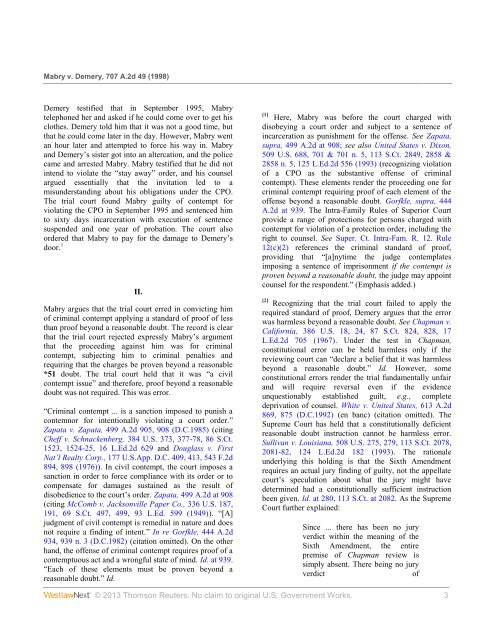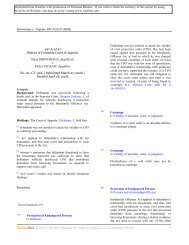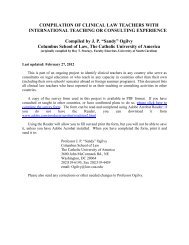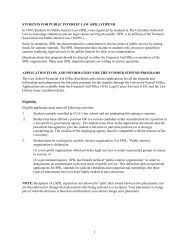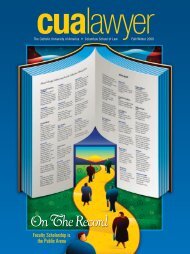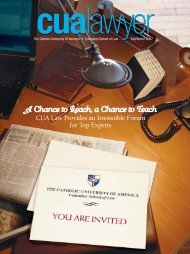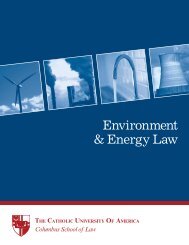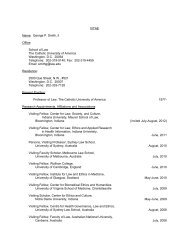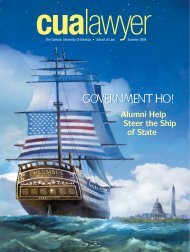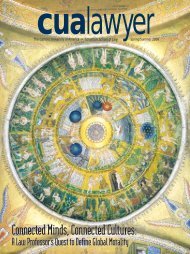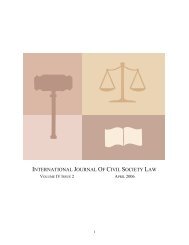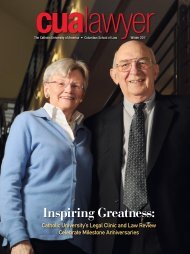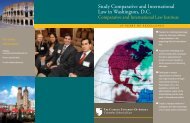Mabry v. Demery - Law Clinics
Mabry v. Demery - Law Clinics
Mabry v. Demery - Law Clinics
You also want an ePaper? Increase the reach of your titles
YUMPU automatically turns print PDFs into web optimized ePapers that Google loves.
<strong>Mabry</strong> v. <strong>Demery</strong>, 707 A.2d 49 (1998)<strong>Demery</strong> testified that in September 1995, <strong>Mabry</strong>telephoned her and asked if he could come over to get hisclothes. <strong>Demery</strong> told him that it was not a good time, butthat he could come later in the day. However, <strong>Mabry</strong> wentan hour later and attempted to force his way in. <strong>Mabry</strong>and <strong>Demery</strong>’s sister got into an altercation, and the policecame and arrested <strong>Mabry</strong>. <strong>Mabry</strong> testified that he did notintend to violate the “stay away” order, and his counselargued essentially that the invitation led to amisunderstanding about his obligations under the CPO.The trial court found <strong>Mabry</strong> guilty of contempt forviolating the CPO in September 1995 and sentenced himto sixty days incarceration with execution of sentencesuspended and one year of probation. The court alsoordered that <strong>Mabry</strong> to pay for the damage to <strong>Demery</strong>’sdoor. 1II.<strong>Mabry</strong> argues that the trial court erred in convicting himof criminal contempt applying a standard of proof of lessthan proof beyond a reasonable doubt. The record is clearthat the trial court rejected expressly <strong>Mabry</strong>’s argumentthat the proceeding against him was for criminalcontempt, subjecting him to criminal penalties andrequiring that the charges be proven beyond a reasonable*51 doubt. The trial court held that it was “a civilcontempt issue” and therefore, proof beyond a reasonabledoubt was not required. This was error.“Criminal contempt ... is a sanction imposed to punish acontemnor for intentionally violating a court order.”Zapata v. Zapata, 499 A.2d 905, 908 (D.C.1985) (citingCheff v. Schnackenberg, 384 U.S. 373, 377-78, 86 S.Ct.1523, 1524-25, 16 L.Ed.2d 629 and Douglass v. FirstNat’l Realty Corp., 177 U.S.App. D.C. 409, 413, 543 F.2d894, 898 (1976)). In civil contempt, the court imposes asanction in order to force compliance with its order or tocompensate for damages sustained as the result ofdisobedience to the court’s order. Zapata, 499 A.2d at 908(citing McComb v. Jacksonville Paper Co., 336 U.S. 187,191, 69 S.Ct. 497, 499, 93 L.Ed. 599 (1949)). “[A]judgment of civil contempt is remedial in nature and doesnot require a finding of intent.” In re Gorfkle, 444 A.2d934, 939 n. 3 (D.C.1982) (citation omitted). On the otherhand, the offense of criminal contempt requires proof of acontemptuous act and a wrongful state of mind. Id. at 939.“Each of these elements must be proven beyond areasonable doubt.” Id.[1]Here, <strong>Mabry</strong> was before the court charged withdisobeying a court order and subject to a sentence ofincarceration as punishment for the offense. See Zapata,supra, 499 A.2d at 908; see also United States v. Dixon,509 U.S. 688, 701 & 701 n. 5, 113 S.Ct. 2849, 2858 &2858 n. 5, 125 L.Ed.2d 556 (1993) (recognizing violationof a CPO as the substantive offense of criminalcontempt). These elements render the proceeding one forcriminal contempt requiring proof of each element of theoffense beyond a reasonable doubt. Gorfkle, supra, 444A.2d at 939. The Intra-Family Rules of Superior Courtprovide a range of protections for persons charged withcontempt for violation of a protection order, including theright to counsel. See Super. Ct. Intra-Fam. R. 12. Rule12(c)(2) references the criminal standard of proof,providing that “[a]nytime the judge contemplatesimposing a sentence of imprisonment if the contempt isproven beyond a reasonable doubt, the judge may appointcounsel for the respondent.” (Emphasis added.)[2]Recognizing that the trial court failed to apply therequired standard of proof, <strong>Demery</strong> argues that the errorwas harmless beyond a reasonable doubt. See Chapman v.California, 386 U.S. 18, 24, 87 S.Ct. 824, 828, 17L.Ed.2d 705 (1967). Under the test in Chapman,constitutional error can be held harmless only if thereviewing court can “declare a belief that it was harmlessbeyond a reasonable doubt.” Id. However, someconstitutional errors render the trial fundamentally unfairand will require reversal even if the evidenceunquestionably established guilt, e.g., completedeprivation of counsel. White v. United States, 613 A.2d869, 875 (D.C.1992) (en banc) (citation omitted). TheSupreme Court has held that a constitutionally deficientreasonable doubt instruction cannot be harmless error.Sullivan v. Louisiana, 508 U.S. 275, 279, 113 S.Ct. 2078,2081-82, 124 L.Ed.2d 182 (1993). The rationaleunderlying this holding is that the Sixth Amendmentrequires an actual jury finding of guilty, not the appellatecourt’s speculation about what the jury might havedetermined had a constitutionally sufficient instructionbeen given. Id. at 280, 113 S.Ct. at 2082. As the SupremeCourt further explained:Since ... there has been no juryverdict within the meaning of theSixth Amendment, the entirepremise of Chapman review issimply absent. There being no juryverdictof© 2013 Thomson Reuters. No claim to original U.S. Government Works. 3


